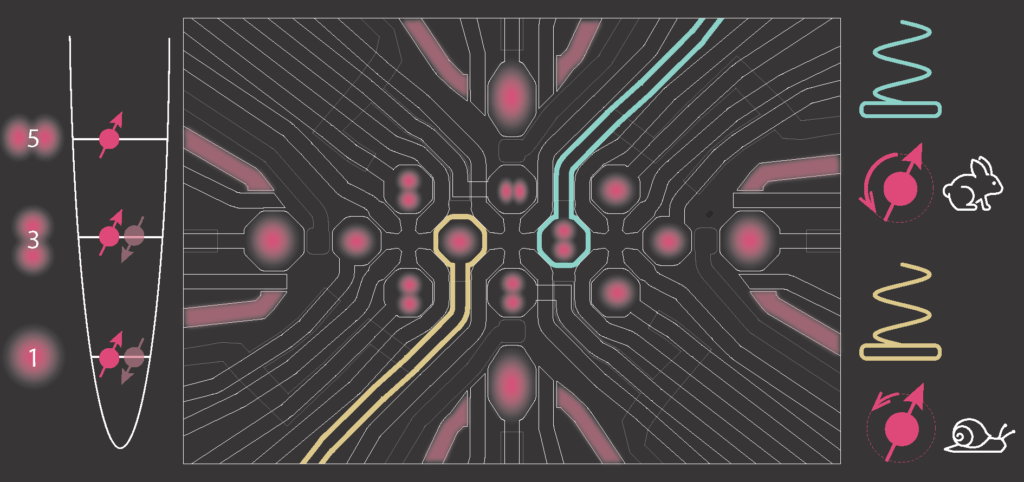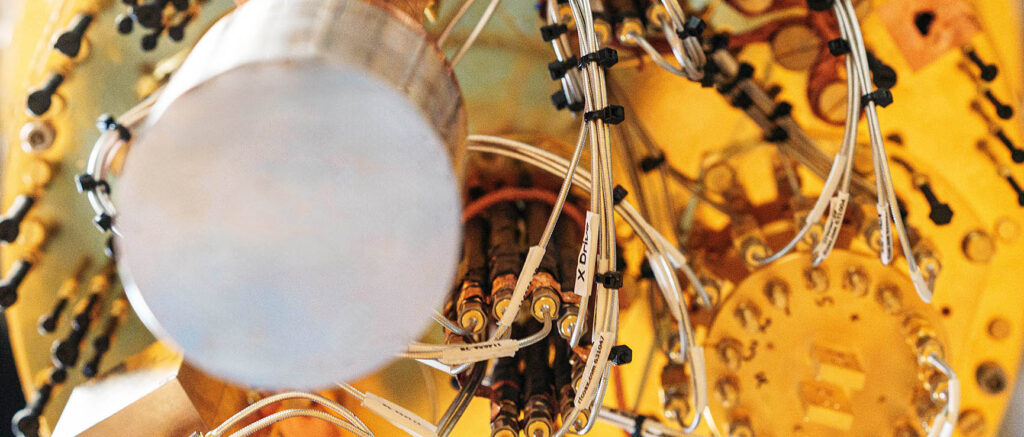27.11.2025Quantum Computing
From Complexity to Control: a 10-spin qubit array in germanium

Spin qubits are compatible with semiconductor manufacturing, but are also highly sensitive to electric fields and device conditions, especially in germanium. Researchers at QuTech have now shown that by tuning the operating regime, this sensitivity can be harnessed rather than avoided. They demonstrate a planar 10-qubit germanium processor with uniform high-fidelity control in a two-dimensional layout where qubits connect to four neighbours, important for quantum error correction. The results are published in Nature Communications.
A new milestone for semiconductor spin qubits
“This is the first time we can systematically operate a two-dimensional array of this size,” says Valentin John, doctoral researcher and shared-first author alongside Cécile Yu. “By increasing the number of qubits and scaling in two dimensions, we are advancing along two critical axes for quantum computation.”
The device is fabricated on a strained germanium (Ge/SiGe) heterostructure: a material system that offers strong spin–orbit coupling. By patterning metallic gate electrodes on top, the researchers define electrostatic potentials that confine individual holes, the positively charged counterparts of electrons, in quantum dots.
The chip features ten quantum dots organised in a 3–4–3 layout, with the two central qubits connected to four neighbours each. This increased connectivity is essential for implementing two-dimensional error-correcting codes: a cornerstone for fault-tolerant quantum computing.
“Having central qubits that couple to four others is not just a geometric curiosity,” explains Menno Veldhorst, principal investigator at QuTech. “It’s the kind of connectivity we need for quantum error correction, where qubits must interact in two dimensions.”

The image shows the 10-spin qubit device in operation with varying charge occupation. Each spin qubit can be driven by oscillating voltage signals applied to any control line, two of which are highlighted here in turquoise and yellow. Depending on the selected control line, the qubit’s relative position, and its occupation, control efficiency varies. Image credit: Valentin John for QuTech.
High-fidelity control and insights into optimal operation
Beyond the size and geometry, the team demonstrated high-fidelity control for all ten qubits, with single-qubit gate fidelities exceeding 99% across the array. They also systematically investigated how to achieve the most reliable and localised qubit operation, which is a crucial step toward scaling.
By varying the hole occupation of each dot (between one, three, or five holes) and the choice of top plunger gate used for driving, the researchers uncovered a clear optimum. “We found that operating the qubits with three holes, driven by the top plunger gate and using a slightly tilted magnetic field, gives the most efficient and robust performance,” explains Valentin John. “This configuration minimises unwanted crosstalk between neighbouring qubits and ensures uniform control across the array.”

The 10-spin qubit array device mentioned in the article
Collaborative Physics-Informed Progress for Germanium Spin Qubits
These experimental results were supported by analytical and numerical modelling performed in collaboration with CEA Grenoble, revealing that the improved performance arises from the anisotropic nature of the quantum states involved. In the three-hole regime, the spin wavefunction takes on a more directional, p-like character, rather than the nearly symmetric form found for a single hole. This gives the qubit a kind of anisotropic ‘personality’: the three-hole spin is more easily driven by the oscillating electric field applied from the top gate. The result is a much stronger coupling between the electric drive and the spin state, enabling faster and more efficient qubit control.
The research demonstrates that the ‘complexity’ of spin hole qubits can be turned into an advantage when the underlying physics is properly understood. By identifying a regime in which hole spins behave predictably and are strongly responsive to local electric fields, the researchers show that robust operation is possible even in dense two-dimensional arrays. This highlights an essential point: advancing quantum hardware engineering still depends on a deep understanding of the quantum physics involved.

